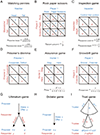Competitive and cooperative games for probing the neural basis of social decision-making in animals
- PMID: 37019249
- PMCID: PMC10175234
- DOI: 10.1016/j.neubiorev.2023.105158
Competitive and cooperative games for probing the neural basis of social decision-making in animals
Abstract
In a social environment, it is essential for animals to consider the behavior of others when making decisions. To quantitatively assess such social decisions, games offer unique advantages. Games may have competitive and cooperative components, modeling situations with antagonistic and shared objectives between players. Games can be analyzed by mathematical frameworks, including game theory and reinforcement learning, such that an animal's choice behavior can be compared against the optimal strategy. However, so far games have been underappreciated in neuroscience research, particularly for rodent studies. In this review, we survey the varieties of competitive and cooperative games that have been tested, contrasting strategies employed by non-human primates and birds with rodents. We provide examples of how games can be used to uncover neural mechanisms and explore species-specific behavioral differences. We assess critically the limitations of current paradigms and propose improvements. Together, the synthesis of current literature highlights the advantages of using games to probe the neural basis of social decisions for neuroscience studies.
Keywords: Behavioral strategy; Game theory; Matching pennies; Reinforcement learning; Social behavior; Social neuroscience.
Copyright © 2023 Elsevier Ltd. All rights reserved.
Conflict of interest statement
Declaration of Interests Authors report no conflict of interest.
Figures



Similar articles
-
Opponent Identity Influences Value Learning in Simple Games.J Neurosci. 2015 Aug 5;35(31):11133-43. doi: 10.1523/JNEUROSCI.3530-14.2015. J Neurosci. 2015. PMID: 26245974 Free PMC article.
-
Human and macaque pairs employ different coordination strategies in a transparent decision game.Elife. 2023 Jan 12;12:e81641. doi: 10.7554/eLife.81641. Elife. 2023. PMID: 36633125 Free PMC article.
-
Cortical mechanisms for reinforcement learning in competitive games.Philos Trans R Soc Lond B Biol Sci. 2008 Dec 12;363(1511):3845-57. doi: 10.1098/rstb.2008.0158. Philos Trans R Soc Lond B Biol Sci. 2008. PMID: 18829430 Free PMC article.
-
[Neural mechanisms of decision making].Brain Nerve. 2008 Sep;60(9):1017-27. Brain Nerve. 2008. PMID: 18807936 Review. Japanese.
-
Social decision-making: insights from game theory and neuroscience.Science. 2007 Oct 26;318(5850):598-602. doi: 10.1126/science.1142996. Science. 2007. PMID: 17962552 Review.
Cited by
-
Frontal noradrenergic and cholinergic transients exhibit distinct spatiotemporal dynamics during competitive decision-making.bioRxiv [Preprint]. 2024 Jan 24:2024.01.23.576893. doi: 10.1101/2024.01.23.576893. bioRxiv. 2024. Update in: Sci Adv. 2025 Mar 28;11(13):eadr9916. doi: 10.1126/sciadv.adr9916. PMID: 38328186 Free PMC article. Updated. Preprint.
-
Deviation from Nash mixed equilibrium in repeated rock-scissors-paper reflect individual traits.Sci Rep. 2025 Apr 29;15(1):14955. doi: 10.1038/s41598-025-95444-6. Sci Rep. 2025. PMID: 40301459 Free PMC article.
-
Frontal noradrenergic and cholinergic transients exhibit distinct spatiotemporal dynamics during competitive decision-making.Sci Adv. 2025 Mar 28;11(13):eadr9916. doi: 10.1126/sciadv.adr9916. Epub 2025 Mar 26. Sci Adv. 2025. PMID: 40138407 Free PMC article.
References
-
- Astur RS, Sutherland RJ, 1998. Configural learning in humans: The transverse patterning problem. Psychobiology 26, 176–182.
-
- Attali Y, Bar‐Hillel M, 2003. Guess where: The position of correct answers in multiple‐choice test items as a psychometric variable. Journal of Educational Measurement 40, 109–128.
Publication types
MeSH terms
Grants and funding
LinkOut - more resources
Full Text Sources

